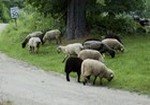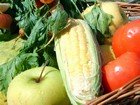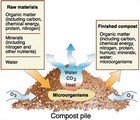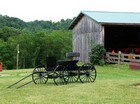4 Main Cover Crops for Organic Farming Green Manures - Rye, Peas, Corn and Clover
The four main cover crops invaluable as green manures: rye, field corn, field peas or cow peas, and crimson clover. When these plants are grown for the sole purpose of slashing and returning to the soil, they are known as green manures.Green Manures are grown primarily to prevent or reduce soil erosion or to provide nutrients to plants that will be grown in that space.
TWO TYPES OF GREEN MANURES
1) Nitrogen Gatherers that covert the nitrogen found in the air into the soil. Usually in the form of legumes.
2) Nitrogen Consumers that cannot perform this function, but use whatever nitrogenous compounds are already in the soil.
Nitrogen Gatherers as Cover Crops and Green Manures
Nitrogen gatherers consist mostly of clovers and vegetables and are valued because they help fix large quantities of nitrogen from the air, making it available to plant roots. Examples of such a green manure would be alfalfa, clovers, soy beans and peas. When these crops are cut down and plowed into the soil they add nitrogenous material to the soil along with other organic compounds. If you are wanting to increase the nitrate levels of your soil, then you should plant these cover crops.
For summer cover crops plant cow peas, soy beans or summer vetch in late spring early summer, and plow under during late summer, early fall.
For fall and winter cover crops, hairy or winter vetch which is frost resistant and crimson clover are most popular, along with field peas. For crimson clover sow this during mid-summer, winter vetch can be sown between July and September, and field peas are sown in August or September. These times are for the northern hemisphere.
Nitrogen Consumers as Cover Crops and Green Manures
Nitrogen consumers consist mostly of grasses and grains and are best used for the short-term production of organic matter for the garden. Buckwheat, rye, cowhorn, turnips and rape. When these plants grow l they do not add nitrogen to the soil, but what they take up in the soil. However, when these crops are plowed under, they then add the nitrogen back into the soil.
Often both types of green manures are grown together for mutual benefit, as one improves the nitrogen content, the other uses the nitrogen produced. Rye and winter vetch are two such crops grow together. Buckwheat and crimson clover is another.
Sometimes all 4 of these are
grown together during the summer month of
July either after an early
vegetable crop has been harvested or during the growing of the
crop.
USE COVER CROPS AND GREEN MANURES TO IMPROVE YOUR SOIL
When the crop is incorporated in the soil, it will immediately start to break down and should be replanted with a follow-on crop as soon as possible. In warm, humid weather, decomposition can occur in less than six weeks.
Clover is one of the most valuable of cover crops to grow, although as you will see below, this is also used as a green manure.
What are the Four Main Cover Crops?
The four
main cover crops invaluable for green-manuring, even when
the same spot must be occupied year in and year out:
- rye
- field corn
- field peas or cow peas
- crimson clover
Rye, as far as I am concerned, is one of the best cover crops that can be grown. It grows anywhere, even in chilly northern winters rye can be sown to resist erosion, control weeds and when turned back into the soil will provide very good organic matter. If you continue to grow rye over just a few winters, your soil structure will improve enormously and will encourage earthworms to take up residence.
If you want to plant rye as a cover crop sow 2-3 ounces of rye seed per 100 square feet of soil. Mow the rye in the spring and turn it under 2-4 weeks before planting your new plants or seeds.
When to Plant Cover Crops
After the 1st September, sow empty fields with winter rye. Sow all ground cleared during August with crimson clover and buckwheat, and mulch the clover with rough manure after the buckwheat dies down. Sow field peas or corn on any land that would otherwise remain unoccupied for 6 weeks or more. All these are sown broadcast, on a freshly raked surface.
SOIL PREPARATION for Cover Crops
To prepare the soil for a green manure crop begin by first chopping and turning under any existing plants growing in the selected area. Smooth off the area thoroughly until you get a fine tilth and add lime if necessarily. Sow the seed, cover with a thin layer of soil and water well.
Sweet clover is a valuable green manure, especially on heavy soils, as it will improve the structure of the soil as it is deep rooted and has lots of foliage. However, as if your soil is acidic your clover crop will fail unless lime is applied shortly before seeding.
WORKING IN YOUR COVER CROPS
Cover crops should always be worked into the soil before they have had a chance to seed or flower, because at this stage the plant is at its strongest and contains the maximum of nutrients. If you have a heavy cropping, it is best to chop the growth down before working it into the soil. The finer the crop is chopped, the quicker it will decompose and add the nutrients to your soil that you are after.
Rye and vetch should be cut and plowed under before it reaches 8 inches in height, as after this it will be difficult and the results not as good.
When you decide it is time to turn your cover crops under the soil, it is important to place a layer of fresh or rotted manure on top of the cover crop so that they are disked in together. The reason for this, is not just in order to improve the soil by adding additional organic material, but the bacteria found in the manure will help breakdown your cover crop more readily, and therefore providing the following crop with readily available plant food.
However, the warmth of your soil in very important for this breakdown to be effective. The ideal soil temperatures you are wanting is 65 degrees F. and above. Spring soils are too cold for this breakdown to take place quickly. If there is very little rainfall and water on the soil then again the breakdown will be slow.
If the conditions are good, then your cover crops should break down within a week. However, if the soil is cold and there is less water about, then the break down could take twice that time, or longer.
SUITABLE GREEN MANURES AND COVER CROPS
Buckwheat as a Green Manure
This is a non-legume green manure and one of the best choices for rebuilding poor or acidic soils. It has an enormous and vigorous root system and is a wonderful plant for attracting the bees. Plant seed in spring, and dig into the soil before it sets its seed. These are very good honey plants for your bees if you are a beekeeper.Cowpea as a Green Manure
This is a legume that is a good soil builder. It has powerful roots. Inoculate the seed when planting for the first time. Sow seed in spring using 90 lbs (40 kg) to an acre or 1 lb (500 g) to each 30 m2.
Fenugreek as a Green Manure
A winter legume cover crop that does best in fairly rich, loamy soils. Use 45 lbs (20 kg) per acre or 1/2 lb (250 g) per 30 m2.
Millet as a Green Manure
Another non-legume, these cover crops do better on poor soil than many other green manure cover crops. Plant thickly using about 37 1/2 lb (17 kg) to an acre, or 1/2 lb (250 g) per 30 m2.
Oats as a Green Manure
A non-legume that can be grown on almost any soil provided the climate is cool and moist. Winter oats are only suited to very mild winters. Sow in the spring using 110 lb (50 kg) per acre of 1 lb (500 g) per 30 m2.
Soybeans and Mung Beans as a Green Manure
These are summer legumes that will thrive on almost any soil type and can withstand long periods of drought. Sow 110 lb (50 kg) per acre or 1 1 lb (500 gm) per 30 m2.
Wheat as a Green Manure
This is another non-legume that prefers a fairly fertile soil with a pH of about 6.4. Sow in the spring using 110 lb (50 kg) per acre of 1 lb (500 g) per 30 m2.Did you find this page helpful?
Sharing is a way of saying, "Thanks!"
Follow Us and Keep Up to Date
BOOKS ON COVER CROPS
You can Add your own Comments on Cover Crops!
We have lots of pages where you can contribute to throughout this homesteading website. We love hearing from our readers, and hope you will be one of those we hear from too. Look around our homesteading website. If you have some comments on cover crops of your own, please submit them. All you need to do is type and submit. We will do the rest!
Leave a Comment
Do you have anything that you would like to add after reading this page? We would love to hear your thoughts. If you can add additional information to what has been written here you will be adding value to the website! No need to have any special skills - just type and submit. We will do the rest!










New! Comments
Do you have something of value to add? Leave me a comment in the box below.